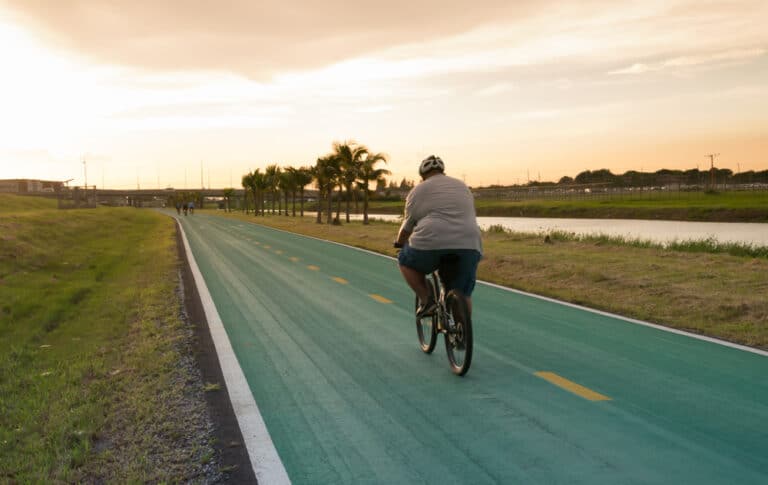Can You Ride A Bike In Lightning?
It is always impressive when you look out over the horizon during a lightning storm. As impressive as it looks, it also can be very dangerous where a staggering amount of energy is produced, and if there was a way to store it, +-8% of American households could be powered.
You may want to ride a bike when there is lightning in the immediate area, but it is extremely unwise. Electricity, and therefore lightning, always seeks the shortest route to the ground, meaning that it may hit the highest object in an area; however, the current also moves across the ground.
If you are riding a bicycle (or motorbike) during a storm and you hear thunder, it is important that you seek appropriate shelter as quickly as possible. Ensure that the shelter you seek is sufficient and does not increase the risk of a lightning strike.
No, You Can’t Ride A Bike In Lightning
If there is any chance of lighting in the area you are riding, immediately find shelter indoors, out of the rain.
It is a myth that the bicycle tires will prevent the electrical current from a lightning strike from grounding the bike.
Thirty thousand amps of lightning charge, at over 100 million volts, at a temperature of 60,000°F and which has traveled down thousands of meters through the non-conductive air, is not going to be obstructed by 20mm of a wet bicycle tire.
There are a few facts about lightning that cyclists often misunderstand.
- All electrical current, particularly lightning, seeks the shortest route to the ground.
- If you are riding over a flat, featureless surface devoid of structures and trees, the rider and the bicycle may be the highest objects in the area.
- It makes the rider and bike potentially the shortest route to the ground and exposes them to a strike.
It is also true in car tires that do not prevent a lightning strike. However, if the car has a solid roof and all windows are closed, the occupants will not be affected because the car acts like a faraday cage.
A Faraday cage is a full metallic body that, when electrified or struck by lightning, does not allow any charge to reach inside. Therefore, if anybody stays inside a full metallic box during a lightning storm, they will be safe even if the box is struck by lightning.
Do’s and Don’ts With Lightning
If lightning is present or even forecast, you should immediately follow the guidelines listed below.
The Do’s With Lightning
The actions you should take if lightning is in your area.
- If a storm suddenly becomes active, get off your bike and walk next to it.
- Never lie down flat on the ground because lightning travels across the ground.
- If you are on a hill or other raised area, move as fast as possible to a low-lying area.
- Immediately seek shelter indoors in a properly constructed building that has electricity (hopefully fully grounded), plumbing (a form of grounding), or an enclosed, metal-topped vehicle with all of the windows up.
- If you hear thunder, it means lightning is in the immediate area, so you should seek shelter.
- Stay in the sheltered indoor area for at least thirty minutes after the last thunder is heard.
- Stay away from windows or external doors.
- Stay away from high structures such as cell phone towers, billboards, or trees.
- Stay away from any natural conductive material, such as barbed wire fences, metal gates, windmills, or power lines.
The Don’ts With Lightning
You should never do the following things if lightning is in your area.
- Do not seek shelter under trees or bushes because this will expose you to a greater chance of a lightning strike.
- Do not seek shelter under a cliff or rocky overhang.
- Do not seek shelter on porches or lean-to’s because this will increase the chance of a lightning strike.
- If lightning strikes outside, don’t believe the fallacy that it doesn’t strike twice in the same place – nothing is stopping it.
- Do not use a corded telephone, computer, or any other device attached to a plug inside the shelter.
- Don’t take a shower to warm up or clean up after the rain if there is still thunder activity in the area.
- Do not lie on a building’s concrete floors or against the concrete walls.
Interesting Facts About Lightning
The following facts about lightning demonstrate the risks of riding a bike in a thunder and lightning storm and the potential for getting seriously injured or even killed.
- Every year there are over twenty-five million lightning strikes in America.
- On average, there are 43 deaths from lightning strikes every year.
- Each year there are 430 non-fatal lightning strikes in America, resulting in varying degrees of disability.
- Lightning can strike from the “sky down” and the “ground up.”
- Lightning doesn’t have to strike you to cause harm directly, and You can be injured or killed if lightning strikes in the proximate area.
- It can be injured or killed if lightning strikes another object in the vicinity and jumps (grounds) through them or from the ground current.
- Most people are injured by lightning because the current travels over the ground surface.
- Many lightning strikes cause injuries because the surges are carried by a telephone, speaker, computer, or any other electrical device into the person.
- Interestingly, the most common injury from lightning strikes is not burns but rather brain injury.
- From a sporting perspective, anglers suffer the greatest number of lightning strikes, followed by boaters and capers, and finally by golfers.
- Thunder and lightning events can be separated by more than ten miles.
- Just because the thunder does not sound too close, you are at risk of a lightning strike
- if you can hear it during a storm.
- Lighting energy can heat the surrounding air to anywhere from 18,000 degrees Fahrenheit to 60,000 degrees Fahrenheit.
Conclusion
Apart from the obvious discomfort of being caught up in a storm, if there is lightning activity, don’t “brave” it out and instead get under appropriate cover as soon as possible.
It isn’t a question of being tough or riding through all weather conditions as 30,000 amps of lightning charge, at over 100 million volts, a temperature of 60,000°F doesn’t play nice when it comes into contact with a person.







